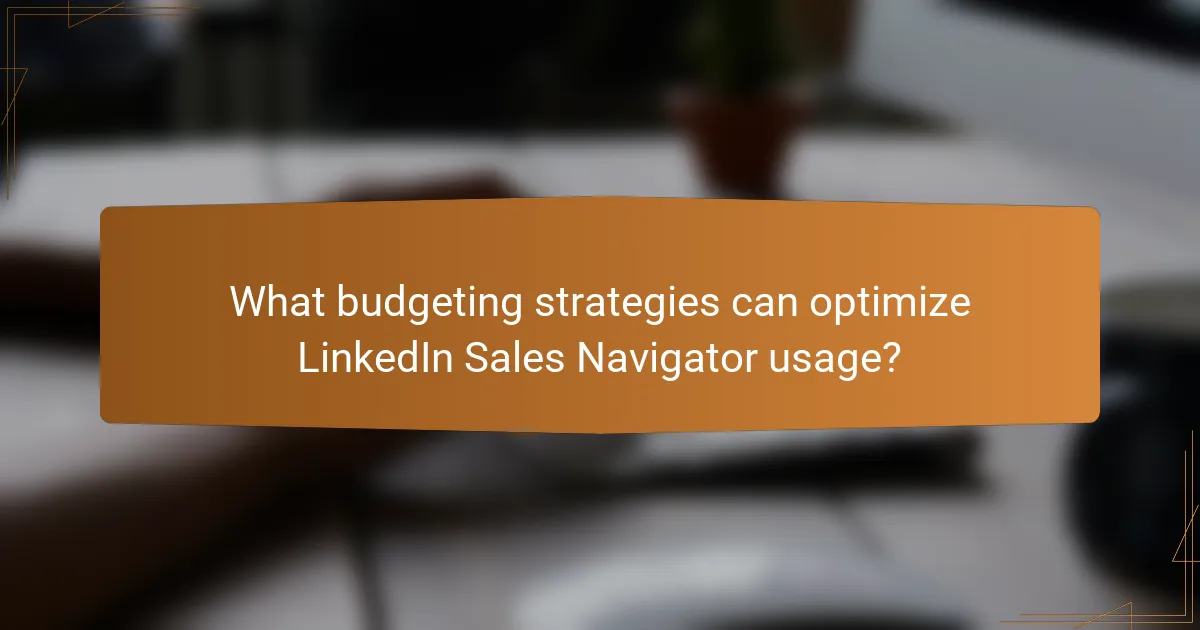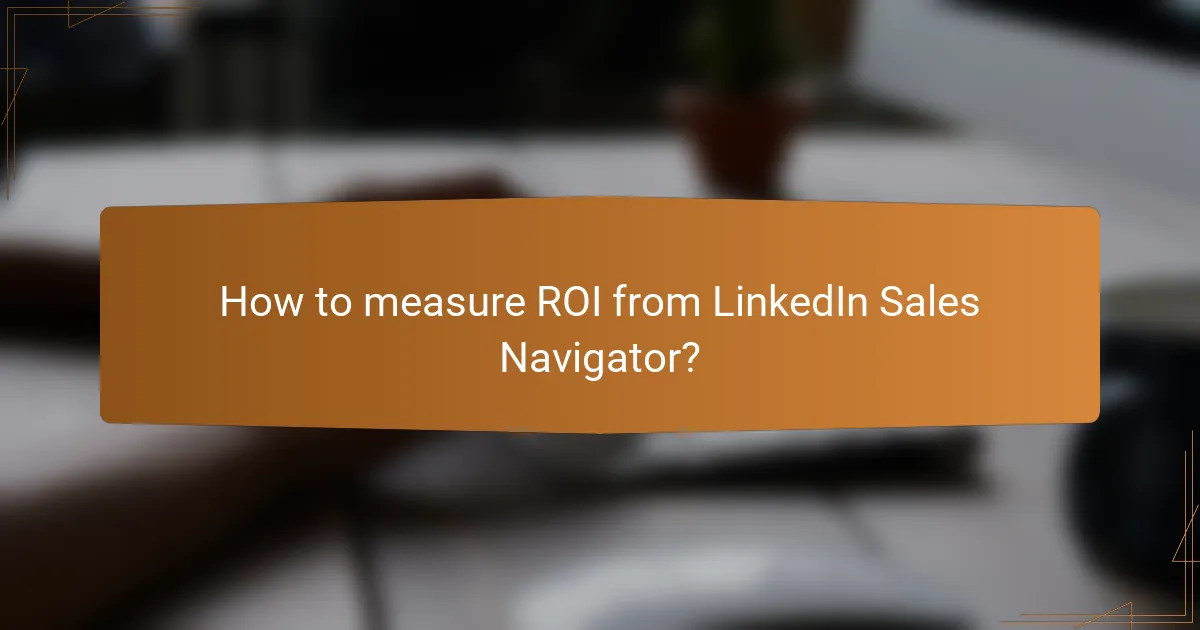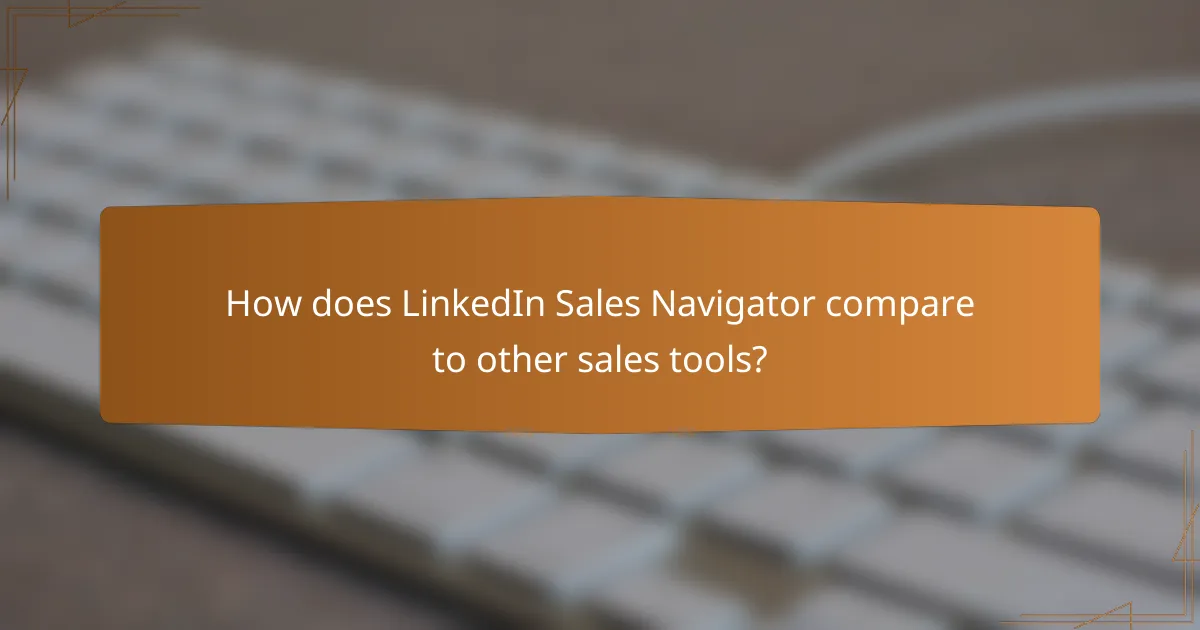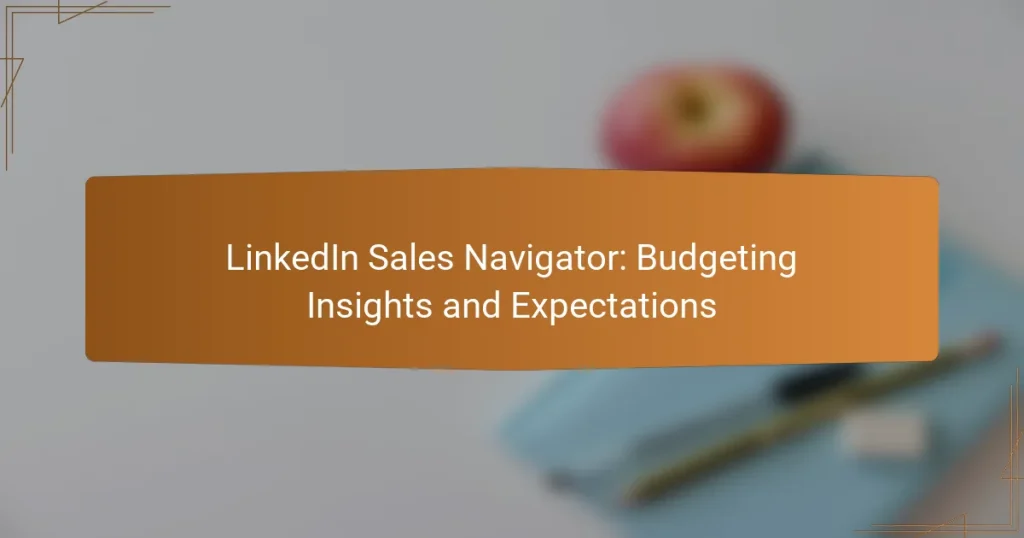Understanding the costs associated with LinkedIn Sales Navigator is essential for effective budgeting and maximizing your sales efforts. With various subscription options available, users can choose plans that best fit their financial strategies while ensuring they leverage the platform’s features effectively. By setting clear financial limits and measuring ROI through lead conversion rates, businesses can optimize their investment in this powerful sales tool.

What is the cost of LinkedIn Sales Navigator in the United States?
The cost of LinkedIn Sales Navigator in the United States varies based on the subscription type chosen. Users can select between monthly and annual plans, each with different pricing structures and potential savings.
Monthly subscription pricing
The monthly subscription for LinkedIn Sales Navigator typically costs around $99.99 per month for the Professional plan. For larger teams, the Team plan is available at approximately $149.99 per user per month, offering additional features tailored for collaboration and management.
It’s essential to evaluate the features included in each plan to determine which best suits your needs. The Professional plan is ideal for individual users, while the Team plan provides enhanced tools for group usage.
Annual subscription discounts
Opting for an annual subscription can lead to significant savings on LinkedIn Sales Navigator. The Professional plan is often priced at about $79.99 per month when billed annually, which translates to a total of around $959.88 per year.
For the Team plan, the annual rate typically drops to about $134.99 per user per month, resulting in a yearly cost of approximately $1,619.88 per user. This option is beneficial for businesses looking to reduce costs while maximizing the platform’s capabilities.

What budgeting strategies can optimize LinkedIn Sales Navigator usage?
To optimize LinkedIn Sales Navigator usage, effective budgeting strategies should focus on setting clear financial limits and allocating resources wisely. This ensures that you maximize your return on investment while leveraging the platform’s features to enhance sales efforts.
Setting a monthly budget
Establishing a monthly budget for LinkedIn Sales Navigator is crucial for maintaining control over expenses. Consider starting with a budget that aligns with your overall sales goals, typically ranging from a few hundred to a few thousand dollars, depending on your business size and needs.
Regularly review and adjust your budget based on performance metrics such as lead generation and conversion rates. This iterative approach allows you to allocate more funds to successful strategies while cutting back on less effective ones.
Allocating funds for training
Investing in training for your team can significantly enhance the effectiveness of LinkedIn Sales Navigator. Allocate a portion of your budget, ideally around 10-20%, for training resources such as workshops, online courses, or webinars that focus on best practices for using the platform.
Consider scheduling regular training sessions to keep your team updated on new features and strategies. This ongoing education can lead to better utilization of the tool, ultimately driving higher sales performance and a stronger return on your investment.

How to measure ROI from LinkedIn Sales Navigator?
Measuring ROI from LinkedIn Sales Navigator involves evaluating the effectiveness of your lead generation efforts against the costs incurred. This can be achieved by analyzing lead conversion rates and engagement metrics to determine how well the tool contributes to your sales goals.
Tracking lead conversion rates
Lead conversion rates are a critical metric for assessing the ROI of LinkedIn Sales Navigator. To track this, monitor the percentage of leads generated through the platform that ultimately result in sales. A typical conversion rate in B2B sales can range from 1% to 5%, depending on the industry and the quality of leads.
To effectively track these rates, set up a clear process for capturing leads from Sales Navigator and integrating them into your CRM system. Regularly review the conversion data to identify trends and adjust your outreach strategies accordingly.
Analyzing engagement metrics
Engagement metrics provide insights into how potential customers interact with your content and outreach efforts. Key metrics include connection requests accepted, messages responded to, and content shares. High engagement rates often correlate with better conversion potential.
Utilize LinkedIn’s analytics tools to assess these metrics over time. Aim for a response rate of at least 20% on your outreach messages. If engagement is low, consider refining your messaging or targeting strategies to better resonate with your audience.

What are the key features of LinkedIn Sales Navigator that impact budgeting?
LinkedIn Sales Navigator offers several key features that significantly influence budgeting decisions for sales teams. Understanding these features can help organizations allocate resources effectively and maximize their return on investment.
Advanced search filters
Advanced search filters in LinkedIn Sales Navigator allow users to pinpoint specific leads and accounts based on various criteria such as industry, company size, and geography. This targeted approach helps sales professionals focus their efforts on the most promising prospects, which can lead to more efficient use of time and budget.
When budgeting for Sales Navigator, consider the importance of these filters in narrowing down leads. Investing in a plan that offers comprehensive filtering options can save costs associated with outreach to less relevant contacts. Aim to utilize filters that align with your target market to enhance lead quality.
InMail messaging capabilities
InMail messaging capabilities enable users to send direct messages to LinkedIn members outside their network, which can be crucial for reaching potential clients. This feature allows for personalized outreach, increasing the chances of engagement and conversion.
Budgeting for InMail usage should account for the number of messages needed to achieve your sales goals. Typically, higher-tier plans provide more InMail credits, so assess your outreach strategy to determine the right plan. Avoid overspending by monitoring your InMail usage and ensuring messages are targeted and relevant to maximize response rates.

What are the prerequisites for using LinkedIn Sales Navigator effectively?
To use LinkedIn Sales Navigator effectively, you need a clear understanding of your target audience and well-defined sales goals. These prerequisites help you leverage the platform’s features to connect with potential clients and drive sales.
Understanding target audience
Identifying your target audience is crucial for maximizing the benefits of LinkedIn Sales Navigator. Start by defining key characteristics such as industry, company size, job titles, and geographic location. This clarity allows you to tailor your outreach efforts effectively.
Utilize LinkedIn’s advanced search filters to segment your audience based on these criteria. For example, if you’re targeting tech startups in Europe, you can filter by company size and location to find the right prospects. This focused approach increases the likelihood of meaningful interactions.
Setting clear sales goals
Establishing clear sales goals is essential for measuring the success of your efforts on LinkedIn Sales Navigator. Goals should be specific, measurable, achievable, relevant, and time-bound (SMART). For instance, aim to connect with a certain number of leads each month or increase your sales pipeline by a specific percentage.
Regularly review and adjust your goals based on performance metrics. If you notice that your outreach is not yielding expected results, reassess your strategy and refine your objectives. This iterative process helps maintain focus and drive continuous improvement in your sales efforts.

How does LinkedIn Sales Navigator compare to other sales tools?
LinkedIn Sales Navigator stands out among sales tools due to its focus on social selling and leveraging professional networks. It offers unique features for lead generation and relationship management that differ from traditional CRM systems.
Comparison with HubSpot Sales
LinkedIn Sales Navigator and HubSpot Sales both aim to enhance sales processes, but they cater to different needs. Sales Navigator excels in providing insights from LinkedIn’s vast professional network, making it ideal for prospecting and building relationships. In contrast, HubSpot Sales offers a comprehensive CRM platform that integrates marketing automation, making it suitable for businesses looking for an all-in-one solution.
When considering pricing, HubSpot Sales typically operates on a tiered subscription model, which can range from free to several hundred dollars per month depending on features. LinkedIn Sales Navigator also follows a subscription model, generally costing between $80 to $150 per month, depending on the plan selected. Businesses should evaluate their specific sales strategies and budget to determine which tool aligns better with their goals.
Comparison with Salesforce
Salesforce is a leading CRM platform that provides extensive customization and robust analytics, while LinkedIn Sales Navigator focuses on social selling capabilities. Sales Navigator enhances Salesforce’s functionality by integrating LinkedIn data, allowing users to find and connect with leads directly within the Salesforce environment.
In terms of cost, Salesforce can be significantly more expensive, with plans often starting in the low hundreds of USD per month per user, depending on the features chosen. LinkedIn Sales Navigator’s pricing is generally more accessible, making it a viable option for smaller teams or businesses focused on leveraging social connections. Companies should assess their sales processes and budget constraints to choose the most effective tool for their needs.

What are the emerging trends in LinkedIn Sales Navigator budgeting?
Emerging trends in LinkedIn Sales Navigator budgeting highlight a shift towards more strategic allocation of resources, emphasizing data-driven decision-making. Companies are increasingly recognizing the importance of analytics in optimizing their investment in this tool.
Increased focus on data analytics
The trend towards data analytics in LinkedIn Sales Navigator budgeting involves leveraging insights to inform spending decisions. Businesses are utilizing metrics such as lead conversion rates and engagement levels to assess the effectiveness of their campaigns.
To implement this, companies should regularly analyze their Sales Navigator usage data, identifying which features yield the highest return on investment. For instance, tracking the performance of InMail messages versus standard connection requests can help refine outreach strategies.
Consider establishing key performance indicators (KPIs) that align with your sales goals. Common KPIs include the number of leads generated, the quality of connections made, and the overall engagement rate, which can guide budget adjustments effectively.


